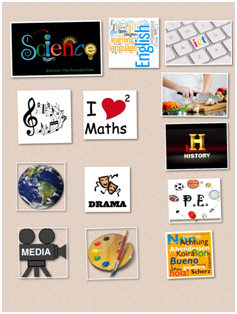
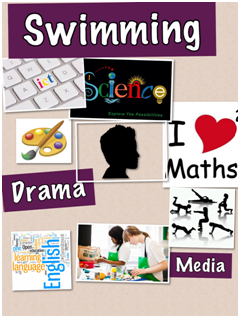
Jacqui
Shepherd
ESRC PhD student, School of Education and
Social Work, University of Sussex
Abstract
This article examines the methodological
approaches used in a research project that investigated the lived experiences
of young people with autism and learning difficulties as they made the
transition from special schools to mainstream colleges of Further Education.
A combination of visual methods, using tablet
applications and walking interviews were explored in an attempt to develop ways
of engaging young people with autism in research and to privilege their voice
in their own transition. The effectiveness and limitations of these methods are
examined here and illustrated through the experience and responses of one young
person in the study and his engagement with the research.
Keywords:
transition; autism; special school; further education; visual methods; learning
difficulties; walking interviews
Introduction
This longitudinal research set out to
understand the experience of transition from the point of view of young people
with autism as they left special school and started at mainstream college. Whilst potentially
unsettling for any young person at this age, this transition can be
particularly challenging for young people with autism, knowing that an
‘anxiously obsessive desire for the maintenance of sameness’ and a ‘dread of
change’ are likely characteristics of autism (Kanner 1943: 245). The
focus of this study was on the transition from a small special school
environment to one of a large mainstream college. All the young people involved
in the study had both autism and a degree of learning difficulty that had
necessitated a statement of special educational need and a specialist
environment. The research was carried out against the
backdrop of a changing policy context where all young people are now expected
to stay in education or training until the age of 18 (DfE, 2008)
and, for young people with a new Education, Health and Care (EHC) plan,
potentially until the age of 25 (DfE et al., 2014). This
was also linked to an increasing emphasis on giving people with learning difficulties
a voice (UNCRPD, 2006) and developing more person-centred planning,
particularly in relation to transition arrangements (DfE & DoH, 2014). With this in mind, the research sought to understand
transition for young people with autism through developing appropriate methods
to listen effectively to their experiences as well as those of their
care-givers and related professionals. The
resulting ‘interrupted interviews’ based on these methods helped to give voice
to the individual participants and communicate their preferences and
experiences. This article focuses on the methodological approaches used in this
project and discusses their strengths and limitations as illustrated by a
single case study of one of the young people in the research.
Autism,
transition and adapted interviews
While a significant cohort of young
people with autism do now progress on to further education (Mitchell 1999; Breakey 2006; Chown & Beavan 2012), the
‘Finished at School’ Report suggested that ‘less than 1 in 4 young people with
autism continue their education beyond school’ (Ambitious About Autism, 2012: 8).
Breakey (2006) argued that reasonable adjustments have to be made for students
with autistic spectrum condition (ASC) when they make the transition to further
education, that pre-access preparation is essential to redress the balance
between them and their neurotypical peers and that many autistic students still
fail to access further education because of the lack of such provision. While
these adjustments have been identified, they do not yet seem to be wholly in
place, ‘with knowledgeable support there can be an improved prognosis for
persons with autism, however, such support is considered to be a rarity in
further education at present’ (Chown
& Beavan, 2012: 477).
Representing the experiences of
the young people in this project was particularly pertinent to its central core
as it sought to focus on the range and diversity of individual young people
with autism. Ways in which to do this ethically and constructively have been
explored in the literature, although there is no conclusive evidence for the
most appropriate method for interviewing people with autism (Lewis & Porter
2004; Nind & Vinha 2013; Palikara et al. 2009; Milton et al. 2012). This area of research is clearly in the process of
development although Preece, albeit writing in 2002, could find very little
published research that had included the direct participation of children with
autistic spectrum conditions.
While semi-structured interviews were an
extremely valuable instrument in gaining the views of the adults in the
research, they were not necessarily the most apposite choice for talking to
young people with ASC and additional learning difficulties. The diversity and
heterogeneity of this group potentially implied that they might not make eye
contact, might not have much language, might struggle with social situations, and
might be disconcerted or made anxious by the presence of strangers (Wing 1996). The
young people in this study all had different communication and social
interaction capabilities and difficulties so they were not a homogenous group. The premise in much of the research
methods literature is about the ability of participants to express themselves
clearly, thoughtfully and openly (Kvale & Brinkmann 2009; Gubrium & Holstein 2002; Weiss 1994) and that the ‘respondent is
someone who can provide detailed descriptions of his or her thoughts, feelings
and activities if the interviewer asks and listens carefully enough’ (Gubrium
and Holstein, 2002: 8). These premises do not necessarily apply to the
participants in this project. However, there was evidence
to suggest that visual stimuli or cue cards (Lewis et al. 2008) and
‘talking mats’ (Cameron & Murphy, 2002) could be helpful to support
communication with those on the spectrum, ‘this is the kind of practical visual
complement to open-ended approaches which is seen as particularly useful for
participants with autism’ (Nind 2009:10).
Potential methodological approaches were
explored in relation to literature on ASC and on research methods. Booth & Booth (1996) explored
the ‘excluded voice thesis’ in relation to people with learning disabilities
and identified four particular challenges when carrying out narrative research
which proved to be useful markers for considering interview research in this
project: inarticulateness which could relate to limited language skills as
well as anxiety in social situations; unresponsiveness
as they might find it difficult to answer open-ended questions; concrete frame of reference which might
be characterised by difficulty in generalising from experience and thinking in
abstract terms and similarly difficulty with imagining the future, and problems with time making it difficult
to order past events.
Preece (2002) identified very limited
research with children and young people with learning difficulties and proposed
that consultation with young people with autism had not considered the specific
impairments associated with ASCs. He concluded that aloofness, social anxiety,
poor memory and the limited and idiosyncratic use of language all impacted on
the ability of those with autism to participate in the consultation process and,
for this study, all these areas had to be taken into account. While there is
little known about which research methods might afford the best opportunities
for the participation of young people with autism (Harrington & Foster 2013), it
is incumbent on researchers to consider the individual, common and exceptional
needs (Lewis & Norwich 2005) of
the participants and design, and adapt methods accordingly. With this in mind, ‘interrupted
interviews’ that involved both the use of collages and card sorts on the tablet
were developed for the early interviews, and walking interviews around the
college environment were planned for the later data collection point.
The
research study
This ESRC funded doctoral
research took the form of a longitudinal case study approach over a ten month
period of data collection from June 2013, when the young people were preparing
to leave school, through to March 2014 when they had spent six months in their
new college settings. The sample comprised six young people with ASC from three
different special schools who progressed on to five different colleges of
further education. They continued on to a variety of courses including BTEC,
Foundation Learning and other vocational courses at different levels. The data
used in this article relates to one student, Jake, in order to illustrate the
methodological approaches used and their relative effectiveness and limitations
in listening to the views of young people with ASC.
Jake:
a case study
Jake is a young man with a diagnosis of
autism and moderate learning difficulties, who was in his final year at a
special school in the South of England when he was first interviewed. He had had a statement of special educational
needs since he started school and had always been educated in special
provision. He had good communication skills and was on the higher functioning
end of the autistic spectrum as evidenced by his progress at school and his
ability to interact well with his peer group and with adults. He was one of the
more able young people in the study, and was able to communicate in complex
sentences and answer open-ended questions in some depth. According to his
Learning Difficulty Assessment (also known as the Moving On Plan) he had difficulty in making
eye contact when stressed, difficulty with understanding facial expressions,
body language and tone of voice and struggled with words that had several
meanings. The ‘interrupted interviews’ helped to support the interview with
Jake and diluted the intensity of the interview scenario.
Jake was initially interviewed at school,
which took the form of a semi-structured interview punctuated by activities that
included making a collage and sorting cards into order of preference on the tablet.
Preece (2002) argued that visually mediated methods strengthened the
communication of young people with ASC in the consultation process. The collage
task required Jake to organize and select both his abilities and interests in
and out of school, as part of the focus here was to focus on his strengths and capabilities.
The images of typical school subjects were pre-loaded and he could remove them,
make them bigger and smaller according to his likes and dislikes, and move them
around. We added the words ‘swimming’, ‘drama’ and ‘media’ because he also wanted
to represent those activities that were partly undertaken outside school.


After some more questions about Jake’s
experience of special school and his preparation for college, a card sort
exercise was introduced. The individual cards held a list of pre-loaded words
or phrases (with some additional blank cards for adding his own ideas) and Jake
had to move the items into the order of perceived importance regarding what he
was looking forward to (Figure 3), and what he was worried about (Figure 4).
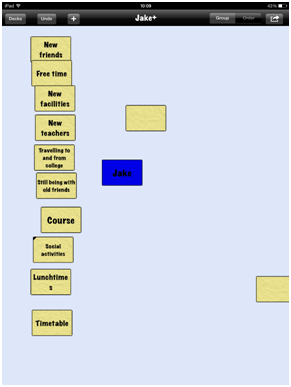
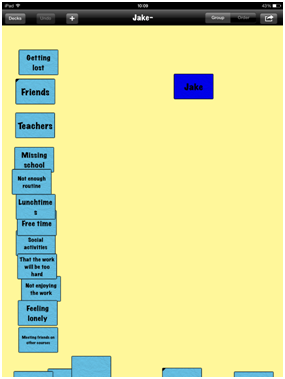
The second data collection
point took place during the Spring Term of Jake’s first year of college, and
after some interim emails during the first term. Jake was interviewed for 30
minutes at home and then during a ‘walking interview’ (Clark & Emmel 2010) at
college. The aim of the interview was to walk around the college environment, led
by Jake, to the places where he attended lessons and socialized in order to
build a picture of his college experience. He was given a tablet to take
photos of places at his college that were significant to him in some way (care being
taken not to include identifiable pictures of other students for ethical
reasons). An extract from the walking interview is given below (Figure 5) in
which Jake indicates how he uses the central facilities at college in his free
time between lessons:

Figure
5. Upstairs in the Learning Resources Centre
Researcher: So do you come in here if you have gaps in between lessons?
Jake : If I have gaps in between lessons,
I sometimes come in here…so yeah, take a picture there. Do you want to go
downstairs and take a picture?
Researcher: I
don't mind. Do you mostly go upstairs or downstairs?
Jake: I go downstairs but I sometimes go
upstairs, downstairs is where you can read the
books down there...[walking downstairs] ...so you've got the ICT, public services, you've got all sorts
of books there
Researcher: Right, that's really good isn't it?
Jake: I'll take a picture there...right
that's taken [takes picture of downstairs in LRC]
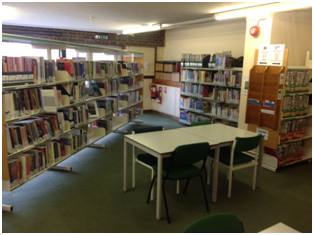
Figure
6. Downstairs in the Learning Resources Centre
Effectiveness
of the methods used
The use of activities on the tablet and also
the walking interviews helped to open up the discussion during the interview, especially
in the first interview when the researcher-participant relationship was newly
formed. Jake showed an interest in the tablet from the beginning of the
interview and was motivated to use it. Although his language skills were very
good and did not suffer from the ‘inarticulateness’ to which Booth & Booth (1996)
refer, he nonetheless had some limitations and idiosyncrasies in his use of
language (Preece, 2002)
which manifested as echolalia, for example,
Researcher: Have you got friends at school?
Jake: I have got friends at school...
and
Researcher:
Right so you're pretty fast then?
[swimming]
Jake: Yes, I'm pretty fast, yes
Using the activities on the tablet helped to
develop the interview into more of a conversation around the subjects that Jake
liked and the activities that he took part in outside school. The walking
interview also helped to support the conversation about how Jake was getting on
at college and demonstrated in a palpable way that he was familiar with the college
environment outside the learning support block,
Jake: Yeah. Performing Arts I could show
you...there are loads of things to show
you...we need the whole day..! If you want to...maybe we should see classrooms
first because there's more classrooms
Researcher: So do you know your way around most of college or just this bit
near here?
Jake: This part really, I mean we went down to the Lowood bit
for the futures fair
that was on which is where you...there were lots of organisations like universities there....
The collage activity and the card sort methods
required some participant reflection and therefore allowed for silences during
the interview involving thinking time or ‘use of pause’ (Lewis 2001), and
the ensuing discussion could then be framed around these visual choices. Jake
was also able to look at the tablet and move things around while we discussed
them,
Researcher: So it's just getting an idea of size so you
can have a fiddle with that
[silence ...32 seconds... while Jake moves
the pictures around]
Jake: I'll put heart maths ....PE is
like there ....[pause while Jake moves the pictures
around]
Researcher: ICT quite big there isn't it?
Jake: Just trying to fit it all in
Researcher: Yeah. [silence...14 seconds... while Jake
continues]
The walking interviews also lent a purpose and
structure to the discussion, whereby we were on a ‘mission’ to take photographs
of the college that resulted in the conversation already having a focus. The
walking interviews took the pressure off the social interaction required and
reduced the need for eye contact and face-to-face talk which some young people
with ASC, including Jake, could find problematic. For example, Jake was able to
respond in some detail to a relatively closed question that might not have been
the case in the intensity of a one-to-one interview,
Researcher: And how are you finding all the work this year? Are you
finding it easy, is it
easier than school? Is it about the same? Is it more difficult?
Jake: Well
I would say it's easier because it's lower quality... but...because last year I was doing
GCSEs, this year it's like entry level...but I am doing functional skills 2 in English which is
equivalent to a C but I would
say it's slightly easier 'cos it's that educational course but...it's
gonna be harder when I do
my next course because that's more mainstream but I think I should cope
well because I know lots of
people
The collage method contained visual symbols
of the main subjects that Jake was likely to be doing at school presented of
equal size and in random order. It was Jake’s task to move them around and
create an arrangement that represented his main interests in some way. This
helped to prompt verbal reactions to certain subjects, and for Jake, to suggest
other subjects or activities that were missing,
Researcher: Oh media, did you say media?
Jake: We have done some media. Not sure
if media's in there [in the choice of
pictures]
Researcher: Shall we add it?
Jake: Yes
Copies of the card sorts and collages that
resulted were emailed to Jake after the interview took place so that he could
have a visual record of what we discussed in the interview. This proved
invaluable at the second round of interviews after a six-month gap as it
addressed some of the issues relating to poor memory (Preece, 2002) by offering
a concrete visual representation and reminder of our conversation. Jake was
able to look back at the collage from the first interview and articulate the
extent to which his interests had changed from the original collage,
Researcher: Do you think anything has changed? Do you think anything has
got bigger or
smaller?
Jake: I'd probably say that's still the case really now
Researcher: Yeah so those are still the things: swimming, IT, science, Maths
are all quite big and
these
Jake: Art,
drama's quite big, English is about medium-sized, media is quite small sized but I'd say
because I do the media um, like a taster in the media, I'd say that has actually, the media has got
bigger
All the methods used within the interviews had
another purpose in helping to readjust the power relationship between the researcher
and participant (Lewis & Porter 2004) by
sharing the process more with the participants themselves. Handing over the tablet
to order the card sorts, to arrange the collage and to take photos all
contributed to this changing relationship to the point where, in the walking
interview, the participant was literally leading the researcher around
unfamiliar territory. The extract below shows Jake leading the way during the
interview and really ‘owning’ the space of his college,
Jake: The
classroom's there and that's T45 and that's also where we do media so I can take it
[takes picture of the media corridor onto which the classrooms open]
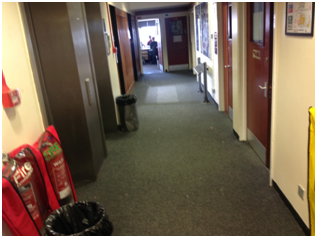
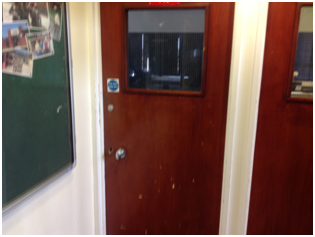
Figure 7. Media Corridor Figure 8. Outside media classroom
Researcher: And have you seen where ICT will be next year, have you seen the classroom that will be
in?
Jake: I've
seen...we went into one of the classrooms where I might go for like my interview so if you want to
see where I went, we could go there if you
want? We can go down and I can show you the ICT and the um...my
normal classroom
Limitations
of methods used
One of the dangers of scaffolding the
interviews and using collages and card sorts with pre-determined choices is
that the results can sometimes be too prescriptive, as Brewster explains, in
relation to interviewing people with learning difficulties with little or no
speech,
“A
characteristic many of these methods share is a reliance on pre-selected
vocabulary; but how do you identify the specific vocabulary without ‘putting
words into their mouths’?” (Brewster et al. 2004: 166)
Jake was able to add some choices to his
collage but did not add any extra cards to the card sorting exercise, and this
may have limited the range of considerations regarding the transition to
college.
It could be argued the these methods could
have been used more effectively if more participation had been sought from the
respondents earlier on in the research process.
Jake was articulate and would have been able to contribute to ideas
about his likes and dislikes at school and his anxieties about college that
could have helped to inform the design of the collages and card sorts to help
with other participants (Nind, 2014).
Discussion
The use of tablet applications during the initial
interviews with Jake helped to structure the interview and direct focus away
from social interaction and towards the tasks, perhaps making it more
comfortable for him. This was particularly helpful at this early point in the
research when the researcher was a complete stranger to Jake and was
interviewing him on his own in a room at school. The applications also helped to make
reflections about capabilities and transition more concrete and that helped to
support Jake in conceptualising the future.
The walking interviews in the college environment also
afforded a greater insight into Jake’s experience in the sense of walking with
him in his journey around college and also allowed him to take the lead in
showing the researcher around his territory, rather than just describing it
(Clark and Emmel, 2010). He was, at that
time, in his second term at college and was already looking forward to moving
on to a level two course within the mainstream of college, the researcher was
able to witness the learning support corridor of classrooms in one block of the
college and was then taken to a busier part of college where Jake would be
taught in the following year. It became
clear that it had been a transition year within college from learning support
to mainstream course and a traditional interview in one fixed place would not
have demonstrated this embodied experience of Jake’s on-going transition.
Conclusion
The methods used in this research were
tentative and experimental but attempted to locate the focus of the experience
of transition for the participants with ASC and learning difficulties by
ensuring that they had a range of opportunities to express themselves. The methods
could also be adapted according to the needs and abilities of different
participants, with more use of visual symbols or fewer symbols used to those
with a greater degree of learning difficulty. While it would be an
exaggeration to claim this research to be truly participatory (Nind, 2014), the
concept of the ‘interrupted interview’ does begin to take small steps towards
more inclusive research. Challenging ourselves to think creatively about
traditional qualitative methods will help to put young people with autism and learning
difficulties at the heart of research, and will deepen our understanding as we
walk with them in their journeys.
Acknowledgements
I am very grateful to the young
people, their families and key professionals who took part in this research and
were willing share their thoughts about transition. In particular, the
participants with ASC who spent time trying out my tablet activities, deserve
special thanks and appreciation. Thanks to the ESRC for funding this research.
References
Booth,
T. & W. Booth (1996), 'Sounds of Silence: Narrative research with
inarticulate subjects' Disability &
Society, 11(1), 55–70
Breakey, C. (2006), The Autism Spectrum and Further Education: a Guide to Good Practice,
London: Jessica Kingsley.
Brewster, S.J., L. Therapist and K. Norton (2004),
'Putting words into their mouths ? Interviewing people with learning
disabilities and little/no speech', British
Journal of Learning Disabilities, 32, 166–169
Cameron, L. and J. Murphy (2002), 'Enabling young people with a learning
disability to make choices at a time of transition', British Journal of Learning Disabilities, 30 (3), 105–112
Chown, N. and N. Beavan (2012), 'Intellectually
capable but socially excluded ? A review of the literature and research on
students with autism in further education', Journal
of Further and Higher Education, 36 (4), 477–493
Clark, A. and N. Emmel (2010), Realities
Toolkit # 13. Using walking interviews,
NCRM
DfE, BIS, DWP, DoH and Ministry of Justice (2014),
Children and Families Act, London:
HMSO
DfE (2008), Education and Skills Act, London: HMSO
Gubrium, J. and J. Holstein (2002), From the Individual
Interview to the Interview Society in Gubrium J. and J.Holstein (eds), Handbook of Interview Research, London:
Sage, pp.3-33.
Harrington, C. and M. Foster (2013), 'Engaging
young people with Autism Spectrum Disorder in research interviews', British Journal of Learning Disabilities,
42 (2), 153-161
DfE and DoH (2014), Special Educational Needs and Disabilties (SEND) Code of Practice : for
0 to 25 years, London: HMSO
Kanner, L. (1943), 'Autistic disturbances of
affective contact', Nervous Child, 2,
217-250.
Kvale, S. and S. Brinkmann (2009), Interviews, Learning the Craft of
Qualitative Research Interviewing, London: Sage
Lewis, A. (2001), 'Reflections on
interviewing children and young people as a method of inquiry in exploring
their perspectives on integration/inclusion', Journal of Research in Special Educational Needs, 1: no.
doi: 10.1111/j.1471-3802.2001.00146.x
Lewis, A., H.Newton and S. Vials (2008), 'Realising child
voice: the development of Cue Cards', Support
for Learning, 23(1), 26-31
Lewis, A. and B. Norwich (2005), Special Teaching for Special Children?
Maidenhead: OUP
Lewis, A. and J. Porter (2004), 'Interviewing
children and young people with learning disabilities: guidelines for
researchers and multi-professional practice', British Journal of Learning Disabilities, 32(4), 191-197
Milton, D. and R. Mills and L. Pellicano (2012),
'Ethics and autism: where is the autistic voice? ', Journal of Autism and Developmental Disorders, 44 (10), 2650-2651
Mitchell, W. (1999), 'Leaving Special School:
The next step and future aspirations', Disability
& Society, 14 (6), 753–770
Nind, M. (2009), 'Conducting qualitative
research with people with learning, communication and other disabilities:
methodological challenges', Available at: http://eprints.ncrm.ac.uk/491/
Nind, M. and H. Vinha (2013), 'Practical
considerations in doing research inclusively and doing it well : Lessons for
inclusive researchers', NCRM
Methodological Review Paper
Nind, M. (2014), What is inclusive research? London: Bloomsbury
Palikara, O., G. Lindsay and J. Dockrell (2009),
'Voices of young people with a history of specific speech and language
difficulties in the first year of post-16 education', International Journal of Language and Communication Disorders, 44 (1),
56–78
Preece, D. (2002), 'Consultation with
children with autistic spectrum disorders about their experience of short-term
residential care', British Journal of
Learning Disabilities, 30, 97-104
United Nations, (2008), Convention on the
Rights of Persons with Disabilities
http://www.un.org/disabilities/convention/conventionfull.shtml
accessed 10th November 2014
Weiss, R.S. (1994), Learning from Strangers: The Art and Method of Qualitative Interview Studies New York: Simon & Schuster
Wing, L. (1996), The Autistic Spectrum, London: Constable & Robinson